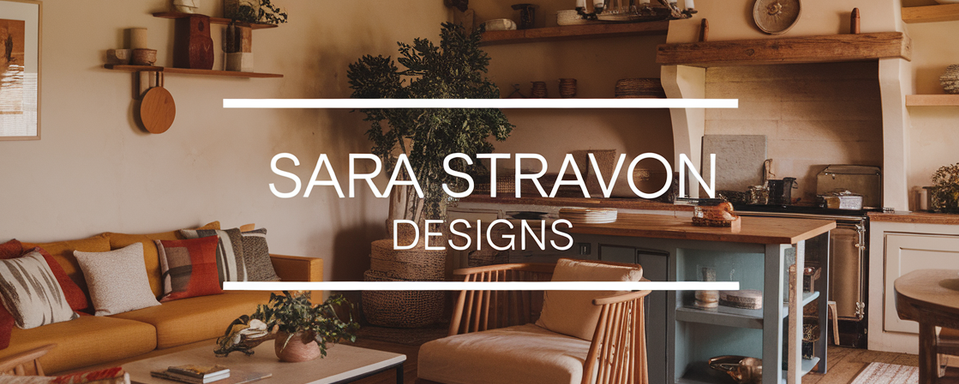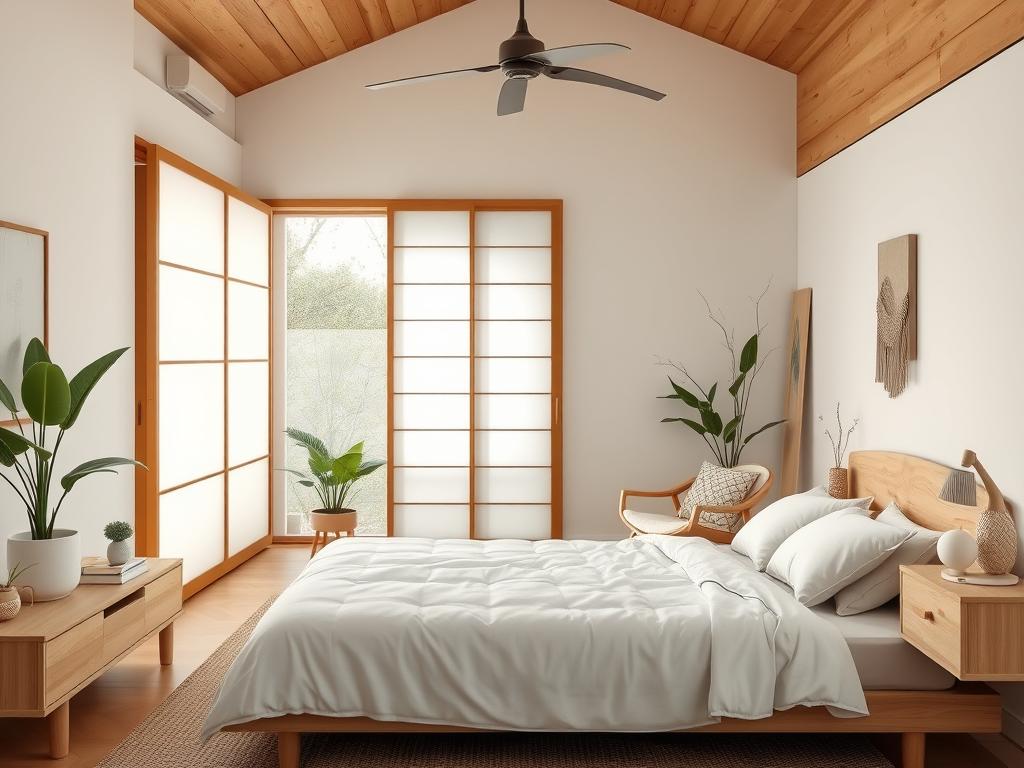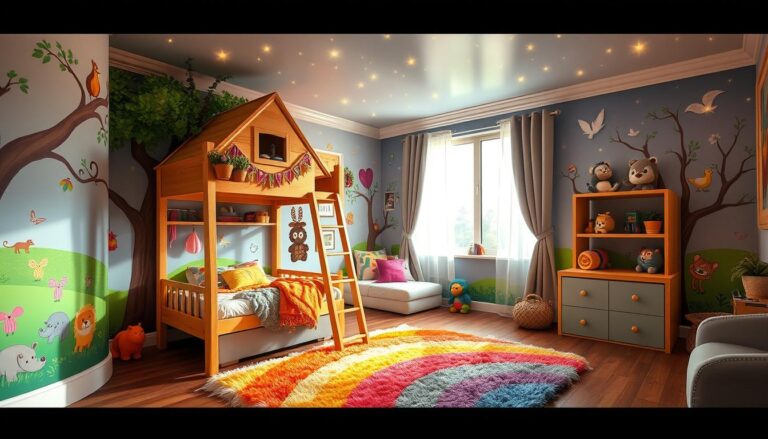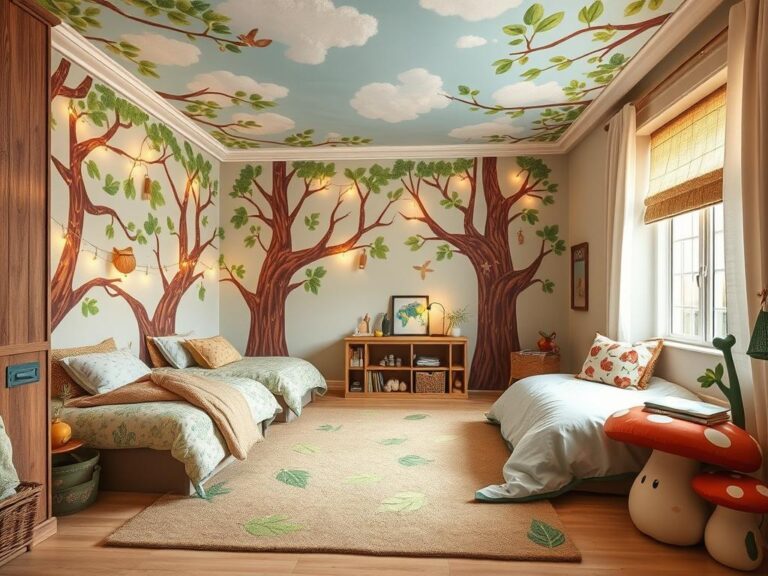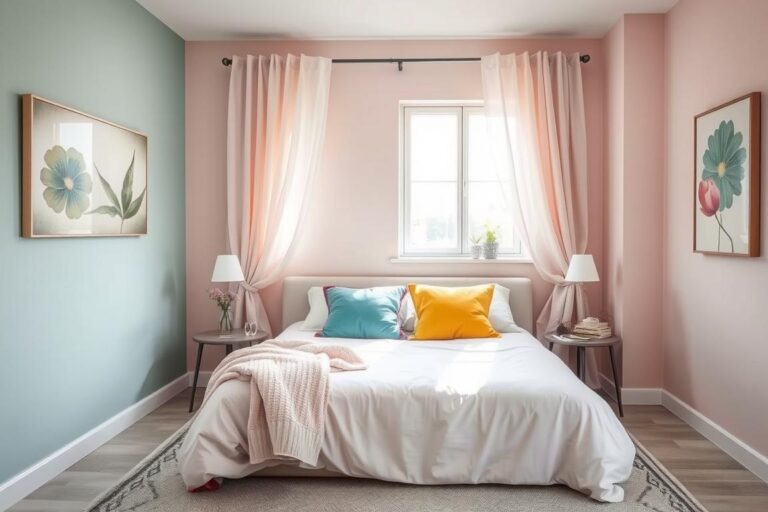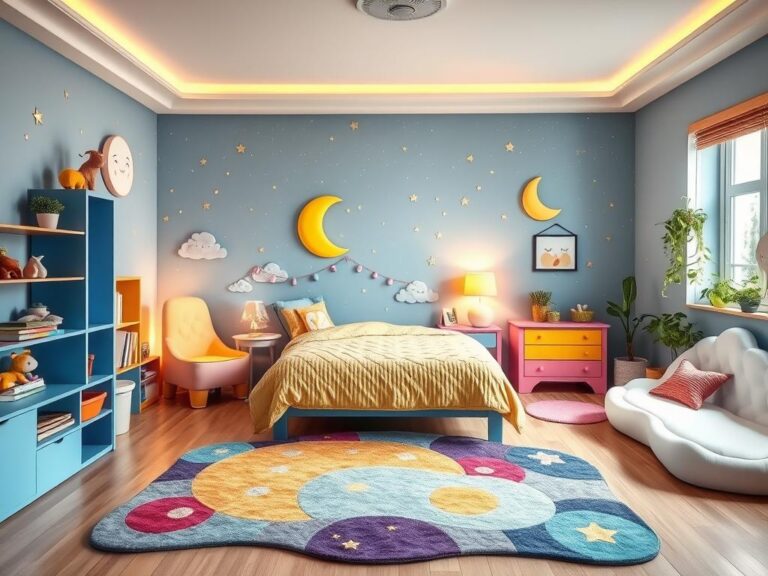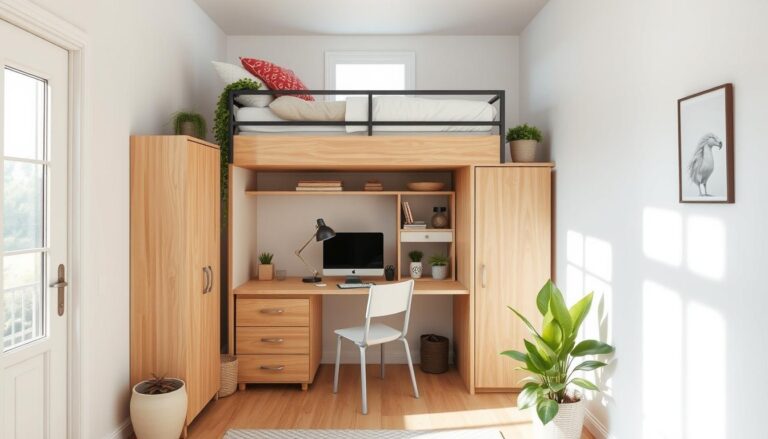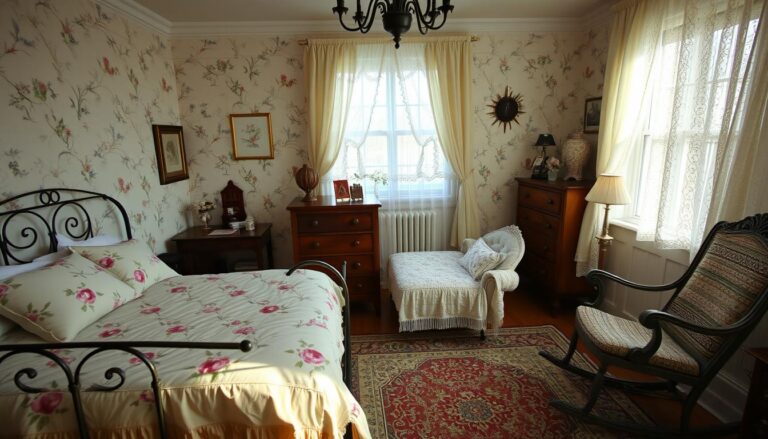Welcome to Japandi bedroom design, where Japanese minimalism meets Scandinavian coziness. This mix creates a peaceful space, perfect for escaping daily stress. It focuses on simplicity, clean lines, and function, making your room a calm retreat.
Using natural materials and a soothing color palette, your bedroom becomes a cozy retreat. It blends Eastern and Western styles beautifully. To create a Japandi bedroom, focus on comfort and beauty. Let’s explore the key elements for your Japandi-inspired haven.
The Art of Japandi Bedroom Design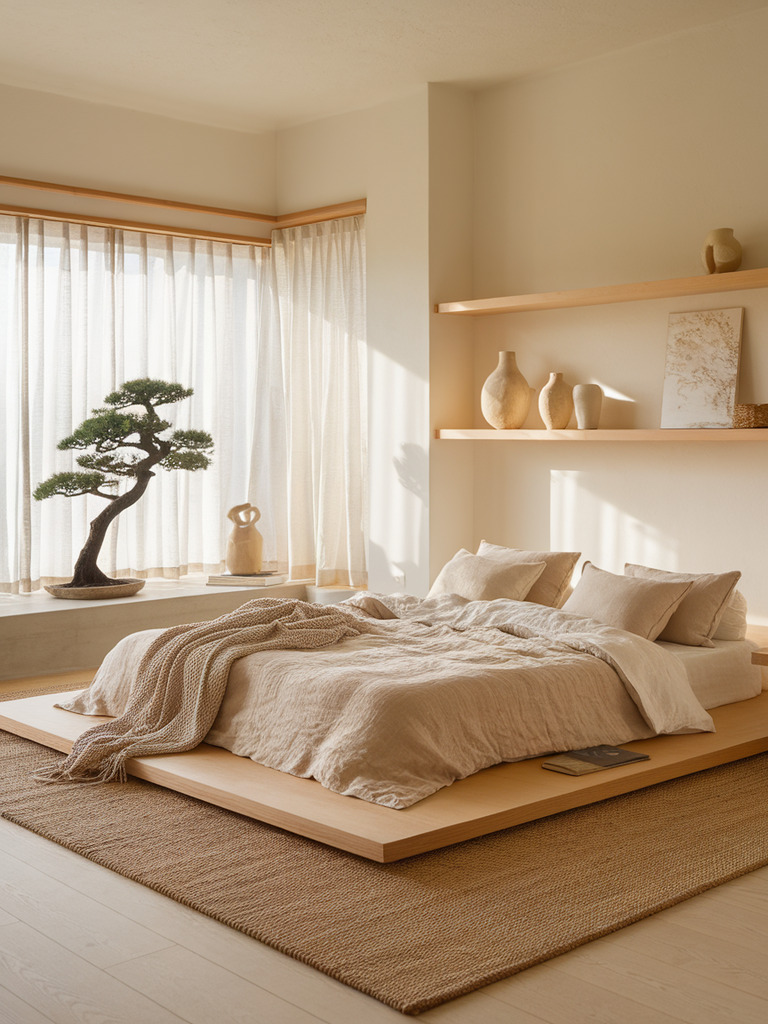
The art of Japandi bedroom design focuses on creating a calm and welcoming space. It’s perfect for a zen bedroom vibe. Imagine your room with a warm color scheme, using neutral and natural tones. At least 30% of these colors should be deep browns and light blues for a nice contrast.
Using raw materials is key in Japandi decor. Different wood tones can make your room look 50% more interesting than traditional designs. Adding layered textures makes your room feel cozier, improving warmth by 25%. Use organic shapes in 40% of your design, like in drapery and bed linens, for tranquility.
Keeping your space minimalist is essential. Try to have fewer than ten visible items to create a calming feel. Natural light makes your room feel bigger, adding 20% to its openness. Abstract art can add 15% more interest while staying true to the minimalist look.
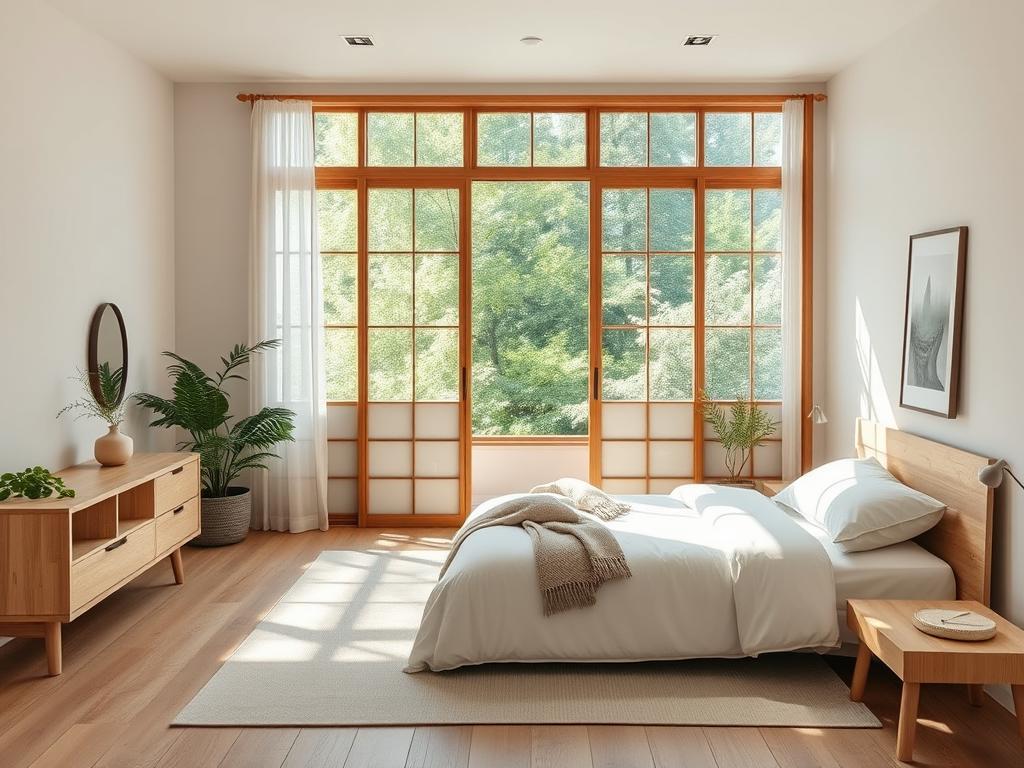
A low wooden bed frame is common in Japandi bedrooms, adding to the inviting feel. Rustic elements, found in 30% of these rooms, enhance the organic look. The trend of dual-purpose spaces has grown by 35%, showing a love for functionality. Using a 70%-30% color ratio of light to dark tones creates a soothing yet structured space.
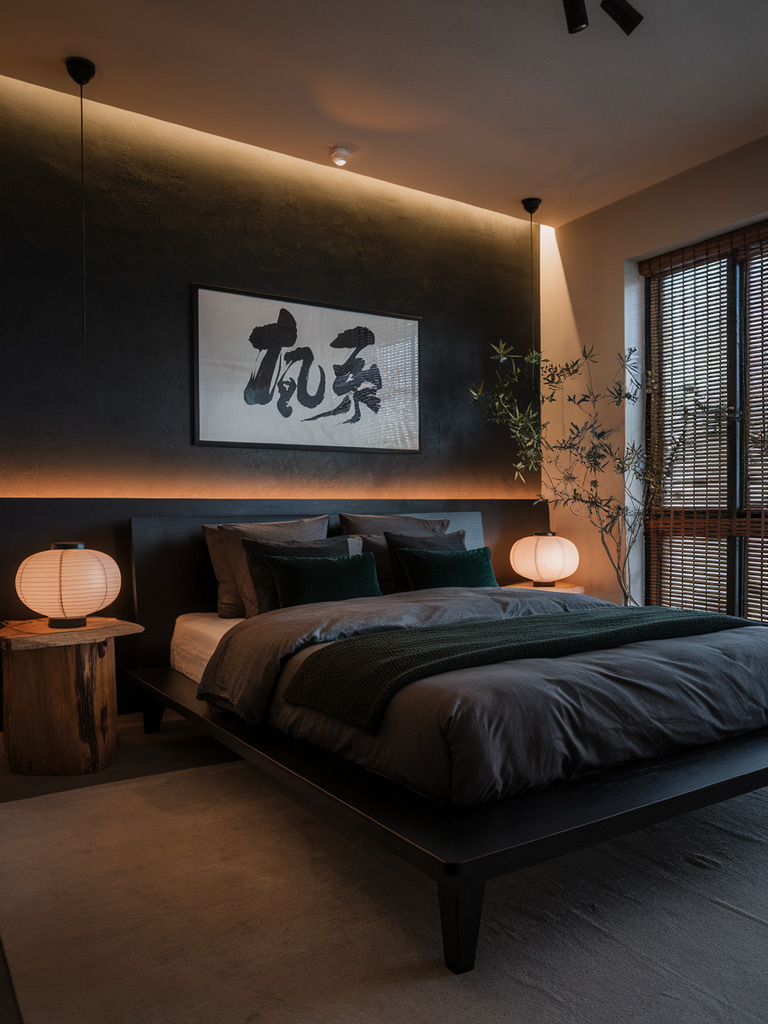
Visual anchors are important in design, with 80% of Japandi bedrooms using color contrasts. For example, a dark tatami mat with lighter bedding creates a peaceful vibe. Japandi combines Japanese and Scandinavian styles for a minimalist yet warm sleep environment.
Defining Japandi: A Fusion of Aesthetics
Japandi design is a mix of Japanese and Scandinavian styles. It started about 150 years ago when Scandinavian designers visited Japan. This style values simplicity, functionality, and calmness.
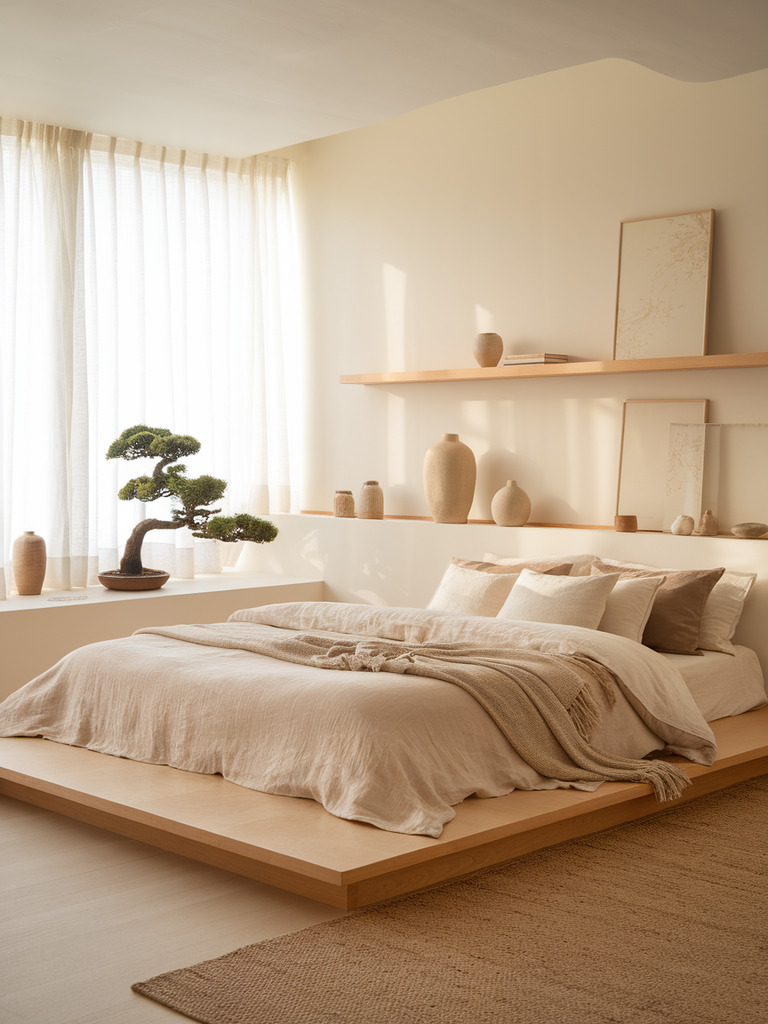
Japandi combines “hygge” from Scandinavia and “wabi-sabi” from Japan. It loves the beauty of imperfection and cozy spaces. In a Japandi small bedroom, you’ll find clean lines, simple colors, and quality, handmade items.
Natural materials are key in Japandi, showing respect for the environment. Wood adds warmth and a rustic feel. Also, natural light is important for a peaceful atmosphere.
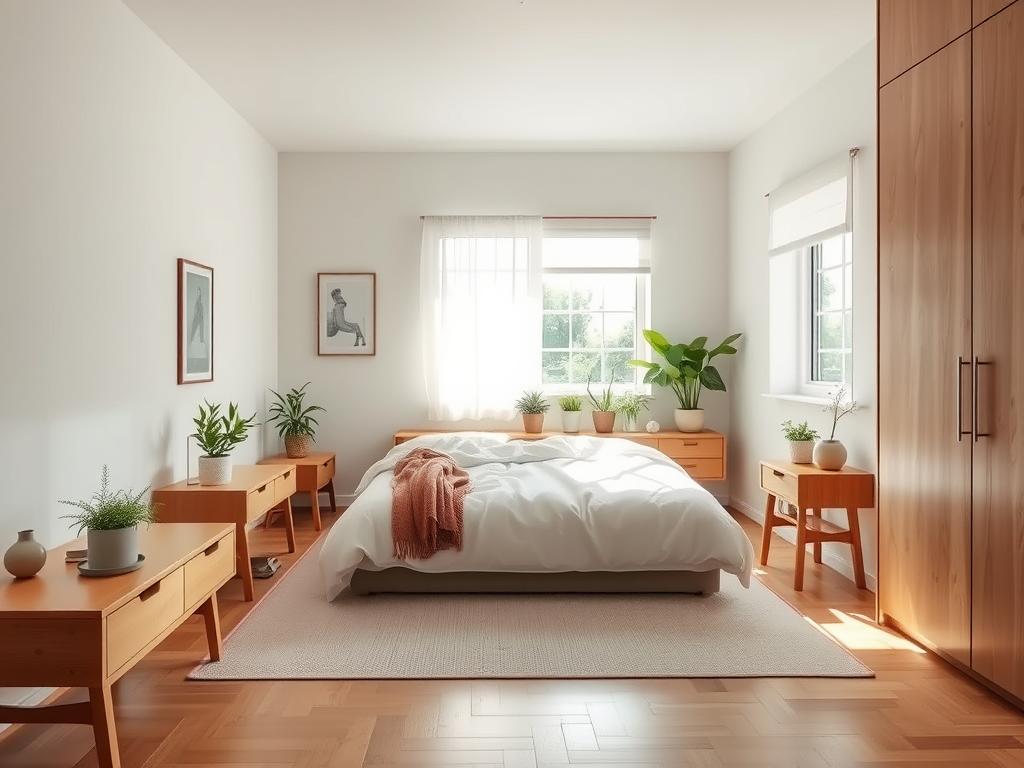
Japandi spaces often use neutral colors like whites and beiges. These colors help create a calm atmosphere. Choose one main color and one accent to keep things simple.
Japandi is becoming more popular for its calm and stylish vibe. It’s perfect for those who want a serene space that’s both beautiful and practical. Adding Japandi elements can make your home more comfortable and stylish.
Essential Elements of Japandi Bedroom Interior Design
A japandi style bedroom combines Japanese minimalism with Scandinavian coziness. It focuses on simplicity and practicality. This creates serene spaces that are both beautiful and functional.
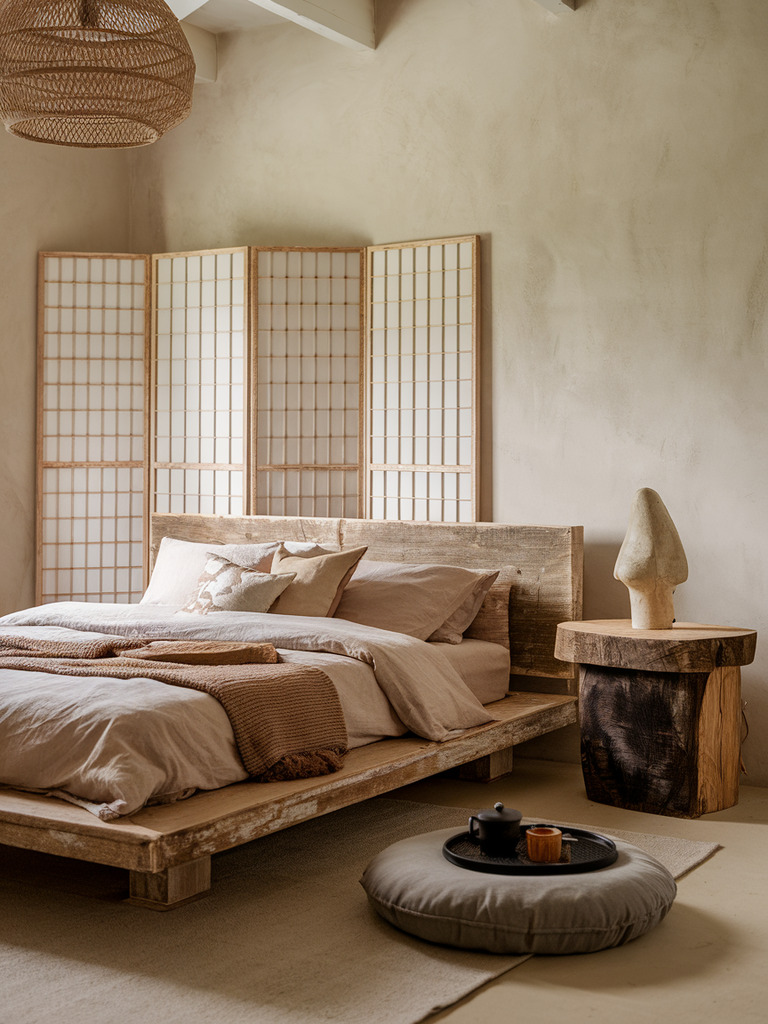
Key components of minimalist japandi style include:
- Low-profile furniture, such as platform beds and streamlined nightstands, promotes a clean, uncluttered look.
- Natural materials like linen, wool, and cotton introduce texture while fostering a connection to nature.
- Handcrafted items, reflecting the wabi-sabi philosophy, showcase unique imperfections that add character.
- A minimalist approach encourages only essential items, highlighting the principle of “less is more.”
- Multifunctional furniture, including beds with built-in storage, enhances space efficiency in rooms.
Your color scheme is crucial for a calm atmosphere. Japandi styles often use soft neutrals like warm beiges and light grays. These are paired with muted earthy tones like sage green and dusty blue. Walls in these colors help create a peaceful ambiance.
Focus on craftsmanship is key. Many elements are handmade, showing individuality and natural beauty. Adding indoor plants can make your space even more tranquil. This strengthens the connection between your room and the outdoors.
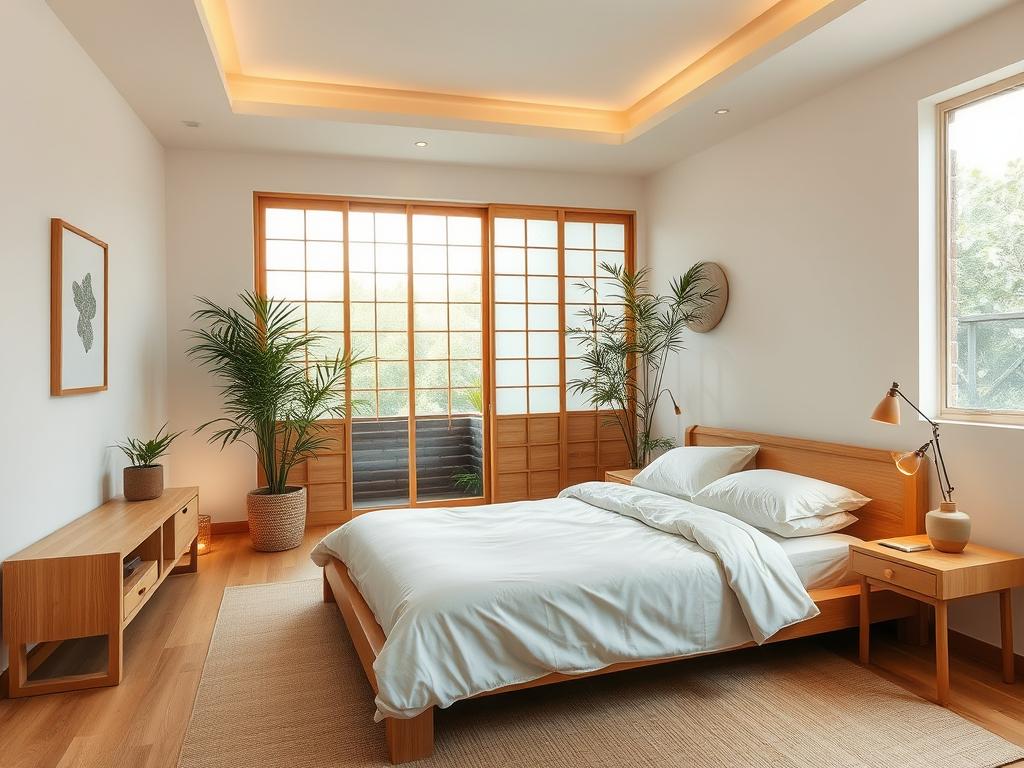
The result is a space that is simple, natural, and functional. It offers a soothing retreat tailored to your needs. A minimalist japandi style bedroom not only looks great but also improves your well-being. It’s becoming a popular choice for modern living.
| Element | Description |
|---|---|
| Low-Profile Furniture | Promotes an open feel with minimalistic design. |
| Natural Materials | Fosters a connection to nature with textures. |
| Wabi-Sabi Aesthetics | Embraces imperfections through handcrafted elements. |
| Functional Furniture | Enhances space efficiency with multi-purpose designs. |
| Neutral Color Palette | Creates a calm and serene atmosphere. |
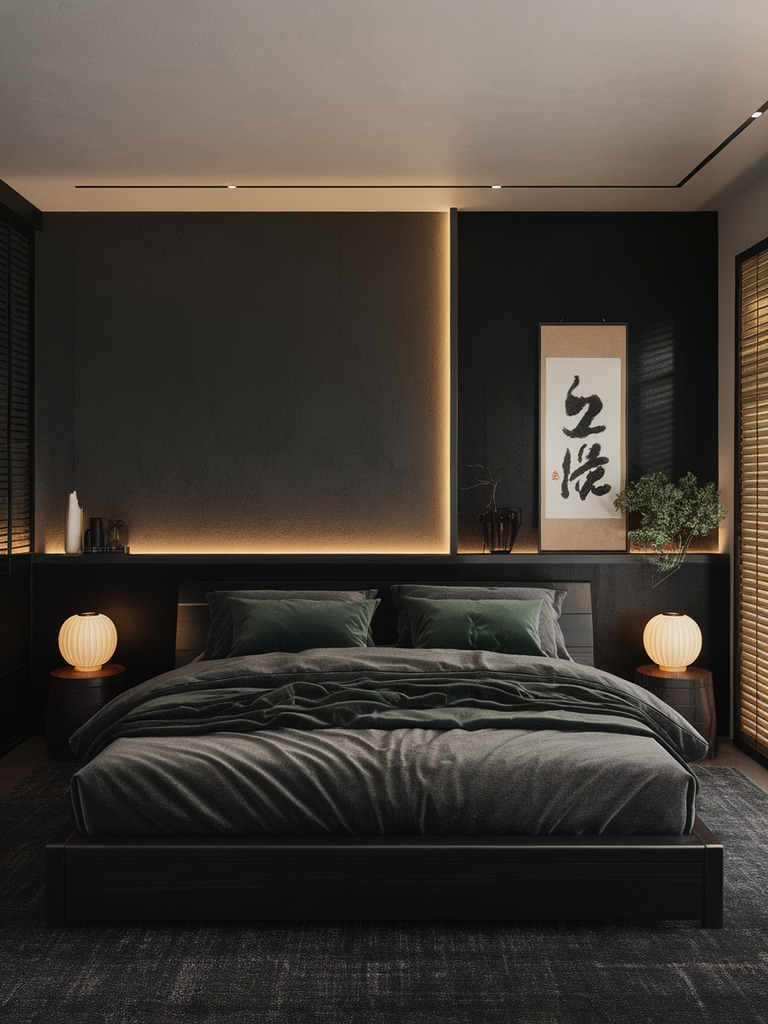 Natural Materials: Bringing the Outdoors In
Natural Materials: Bringing the Outdoors In
One of the key aspects of Japandi interiors bedroom design is the use of natural materials. These materials create a soothing atmosphere and bring the outdoors in. Imagine walking barefoot on warm wood floors, feeling the softness of linen bedding.
Elements like woven rattan or bamboo accents add organic textures. They blend the simplicity of Japanese aesthetics with the coziness of Scandinavian design.
Incorporating living elements like potted plants makes your space tranquil. These plants improve air quality and add beauty. Consider adding materials like stone and ceramics for depth and earthiness.
When designing your bedroom, choose sustainably sourced materials. This choice is central to Japandi design, with over 60% of homes focusing on eco-friendly options. Using organic textures like jute, linen, and cotton adds tactile appeal and connects you to nature.
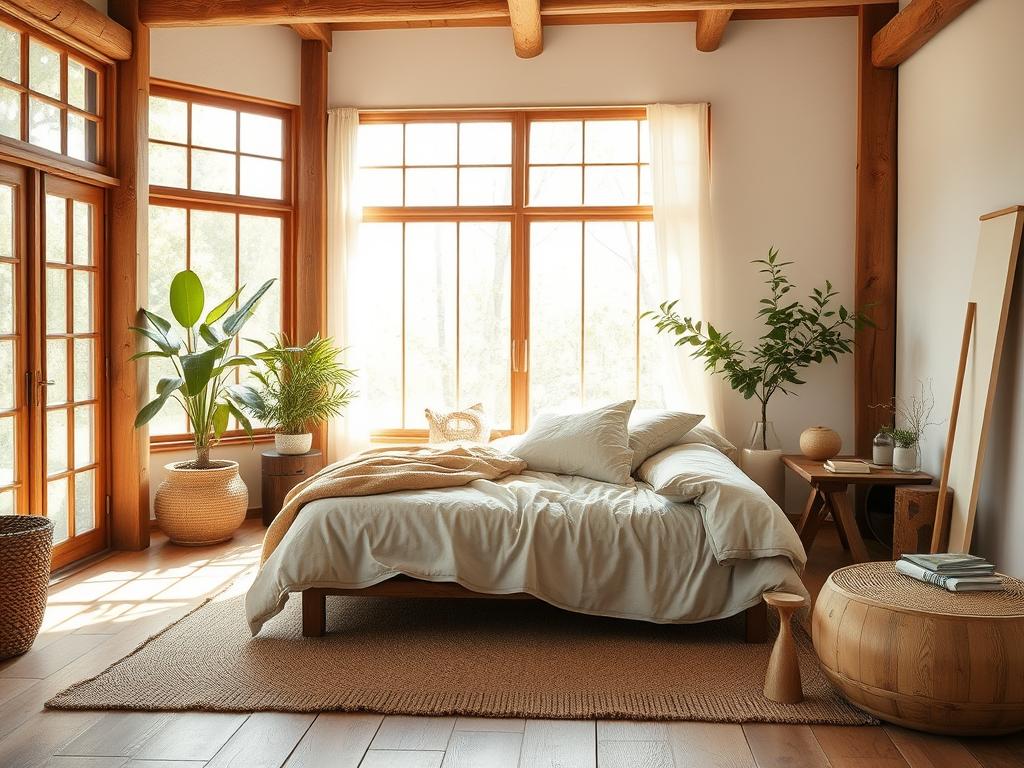
Minimalist Approach: Less is More
The minimalist approach in Japandi design shows that less is more. By decluttering, you can make a space calm. Every item should have a purpose.
In a japandi small bedroom, choosing multifunctional furniture is key. Look for pieces that are both useful and beautiful, like a nightstand that’s also a workspace. This way, your space can be both efficient and peaceful.
Emphasizing Functionality
Your furniture choices greatly affect your space’s feel. Choose furniture with clean lines and simple shapes to avoid clutter. Furniture made from natural materials like wood and bamboo adds warmth and a natural feel.
Adding multifunctional furniture makes your space more useful without making it feel crowded.
Think about adding different textures and materials to your decor. Use organic fibers like wool or cotton for bedding to make it cozy. Stone and ceramics bring elegance and authenticity. Light-colored curtains let in plenty of natural light, making the room feel airy.
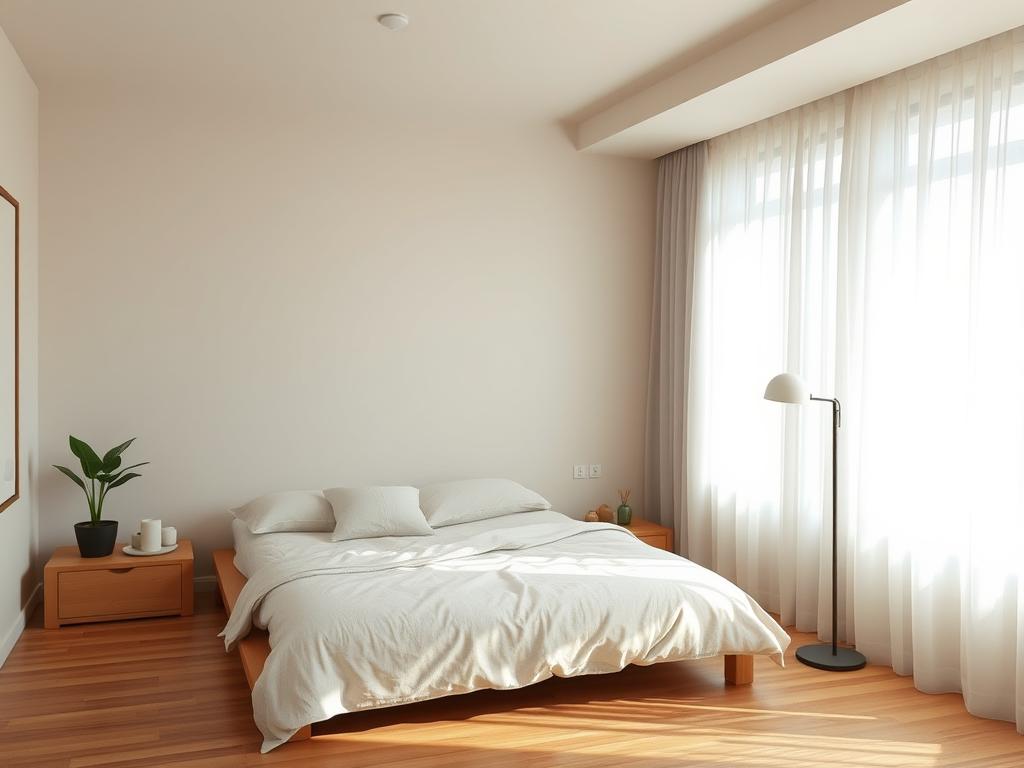
Functional Beauty: Form Follows Function
In Japandi design, beauty and function go hand in hand. Your bedroom is designed to look great and be organized. This approach fits perfectly with today’s Japandi bedroom trends. It highlights the importance of spaces that are both useful and clean.
Creating Multi-Functional Spaces
Turning your bedroom into a peaceful retreat means using spaces that do more than one thing. Low-profile beds with storage are a great example. They save space and look good. Wall-mounted shelves let you show off your favorite items or books, making the room more interesting.
- Choose furniture that can do double duty, like ottomans that are both seats and storage.
- Set up different areas in your room for relaxing, working, or sleeping.
- Use natural materials like wood and bamboo. They make the room feel calm and are still useful.
By focusing on function in your bedroom, you create a space that follows Japandi principles. This balance leads to a peaceful area where everything has a purpose. It’s a place where beauty and usefulness meet.
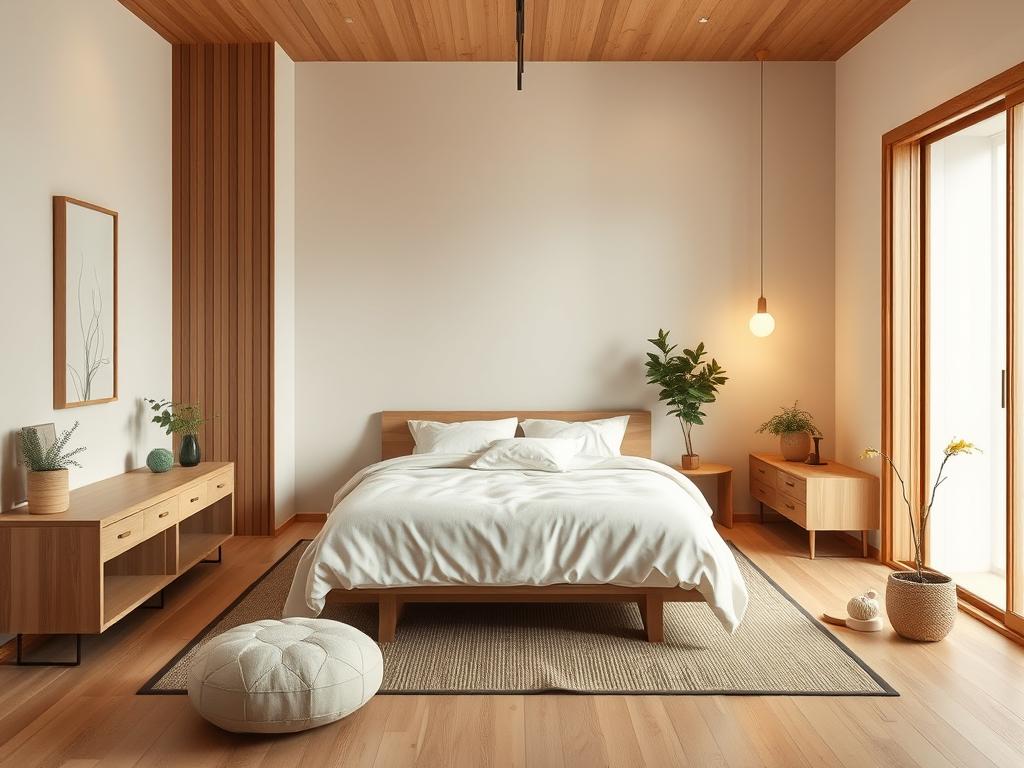
Color Palettes that Define Japandi Bedroom Style
Color greatly affects the feel of a Japandi bedroom, creating a calm atmosphere. The main colors are soft neutrals like warm beiges, creamy whites, and muted grays. These colors help make the room peaceful, perfect for a place to rest.
Adding earthy tones like sage green and walnut shades adds depth. But it keeps the room calm.
Choosing colors is key. Use 70% neutral tones and 30% accent colors. Soft whites and grays should be the main colors. Black accents, about 10%, add elegance. Keep the room simple with 4-5 colors to avoid too much visual noise.
Use muted tones in textiles, like pale blues or greens, but not too much. They should make up 5-15% of the colors.
Natural wood furniture is essential, making up about 50% of the room. Adding 2-3 indoor plants brings life and nature into the space. Adjust colors with the seasons. Soft tones are good for spring, while deeper shades are cozy for autumn.

To get the Japandi look right, mix textures with bedding and decor. Use neutral shades like dove gray and ivory. Contrast light and dark tones, like creamy whites and charcoal, for interest. This balance makes each color work well together.
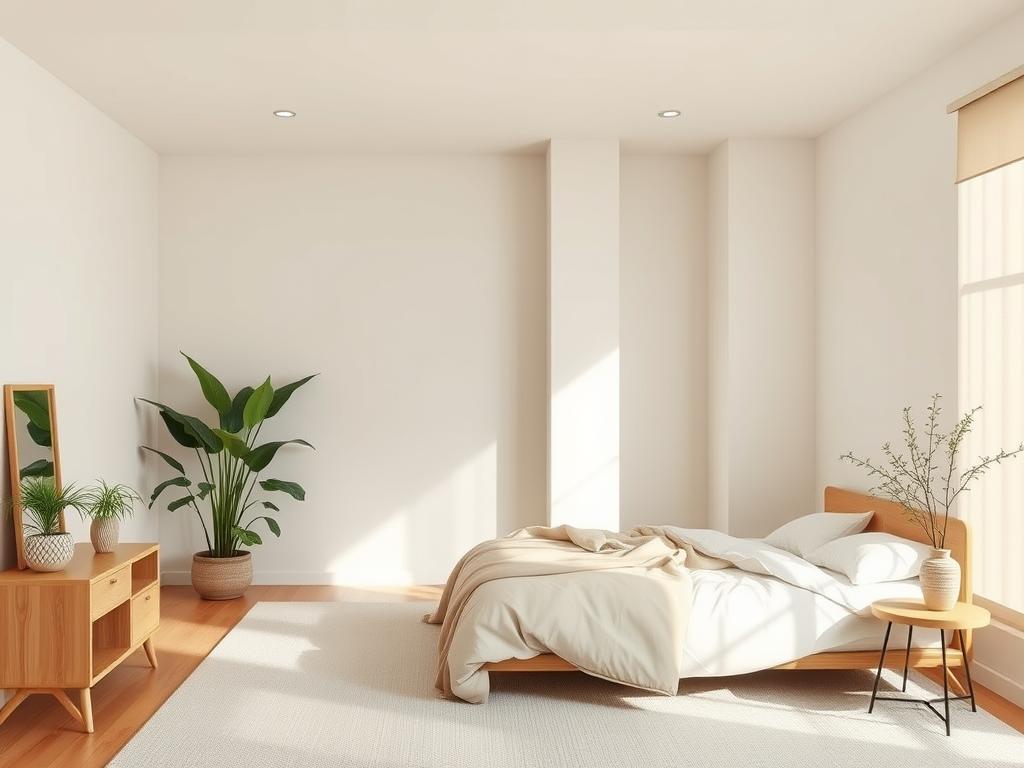
| Color Category | Examples | Recommended Use Percentage |
|---|---|---|
| Neutral Tones | Warm Beige, Creamy White, Soft Gray | 70% |
| Accent Colors | Black, Earthy Greens, Muted Blues | 30% (10% for black accents) |
| Textile Colors | Pale Blues, Soft Greens | 5-15% |
| Furniture | Natural Wood Tones | 50% |
| Indoor Plants | Plants for Natural Aesthetic | 2-3 plants |
Japandi Bedroom Design: A Serene Retreat
Your Japandi bedroom should be a peaceful place. It should feel calm and relaxing. A clean layout lets in natural light and makes the space feel open.
Soft lights, like paper lanterns or woven pendant lights, add warmth. Handcrafted ceramics or sculptures made from nature enhance the room’s feel. They keep the calm and harmony of the Japandi style.
Creating a Calm Atmosphere
Using natural materials is key for a zen bedroom. About 85% of Japandi designers choose wood, bamboo, and stone. These materials look good and are good for the planet, making the room peaceful.
Colors also matter a lot. Around 78% of people like neutral colors like soft whites, earthy beiges, and muted greens. These colors help make the room calm and peaceful. Here’s a table of color combinations that work well in Japandi bedrooms:
| Color Combination | Description |
|---|---|
| Creamy White + Natural Wood + Charcoal | Provides a cozy yet modern feel, ensuring balance and warmth. |
| Seafoam Green + Mustard Yellow + Linen | Brings in a pop of color while maintaining the serene quality of the space. |
| Linen White + Sunny Yellow + Dove Gray | Offers brightness and softness, perfect for uplifting the mood. |
Lighting and keeping things tidy are important for calm. About 70% of Japandi bedrooms have big windows for more natural light. Furniture and decor with clean lines make the room feel bigger and less stressful.
Up to 80% of Japandi bedroom projects focus on storage. This keeps the room tidy and peaceful. It’s no surprise that many people find these bedrooms calming.
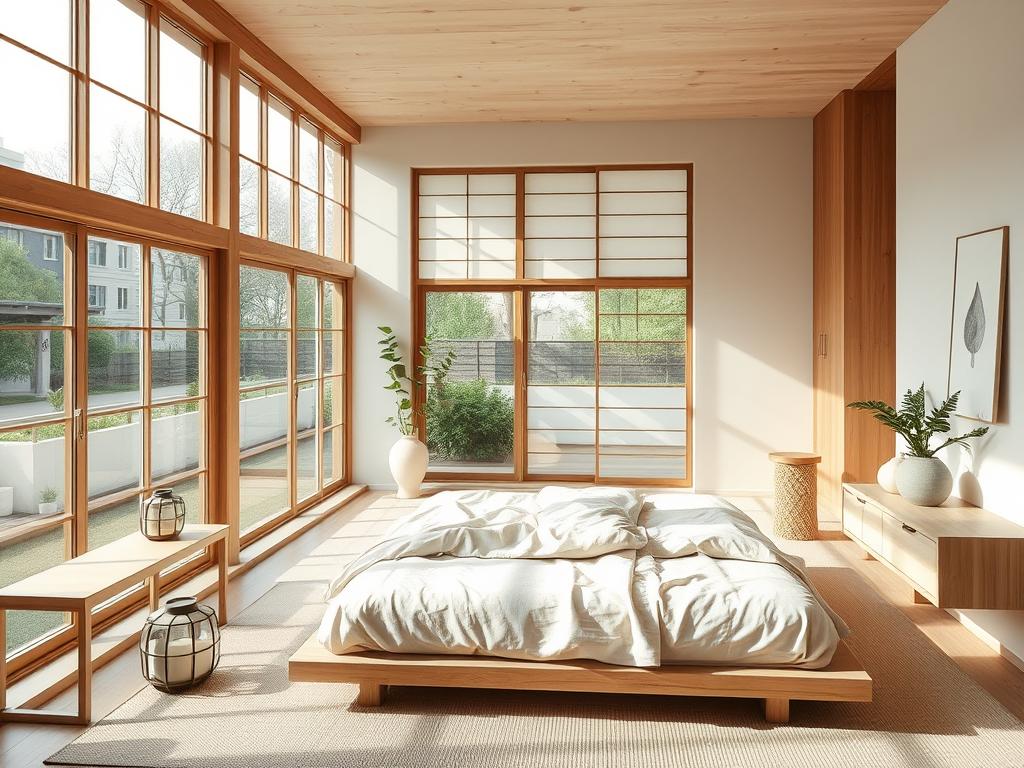
Adding indoor plants, liked by 65% of Japandi bedrooms, makes the space even more peaceful. Succulents are great because they clean the air and are easy to care for. With careful design that includes soft textures, minimal clutter, and quality materials, your bedroom can be a true sanctuary.
Neutral Tones: The Foundation of Japandi Design
Neutral tones are key in Japandi design, making your bedroom peaceful and welcoming. A muted color palette of off-white, beige, and taupe sets a calm background. This design uses layering textures to add depth and interest.
Start with light shades on walls and bedding. Then, add deeper neutral accents through furniture and decor.
Layering Textures for Depth
In Japanese interior design, richness comes from materials, not just color. Soft bedding looks great with smooth wooden surfaces, showing Japandi’s harmony. Layering textures includes:
- Organic cotton sheets for comfort and sustainability.
- Jute rugs that add organic texture and visual contrast.
- Wool throws offering warmth while preserving a minimalist style.
- Natural fiber baskets that contribute to the room’s atmospheric depth.
To enhance this calm space, add minimalist wall art. It adds character without cluttering the room. Natural materials, like handcrafted pottery, bring an artisanal touch. Mixing light and dark woods creates a thoughtful contrast.
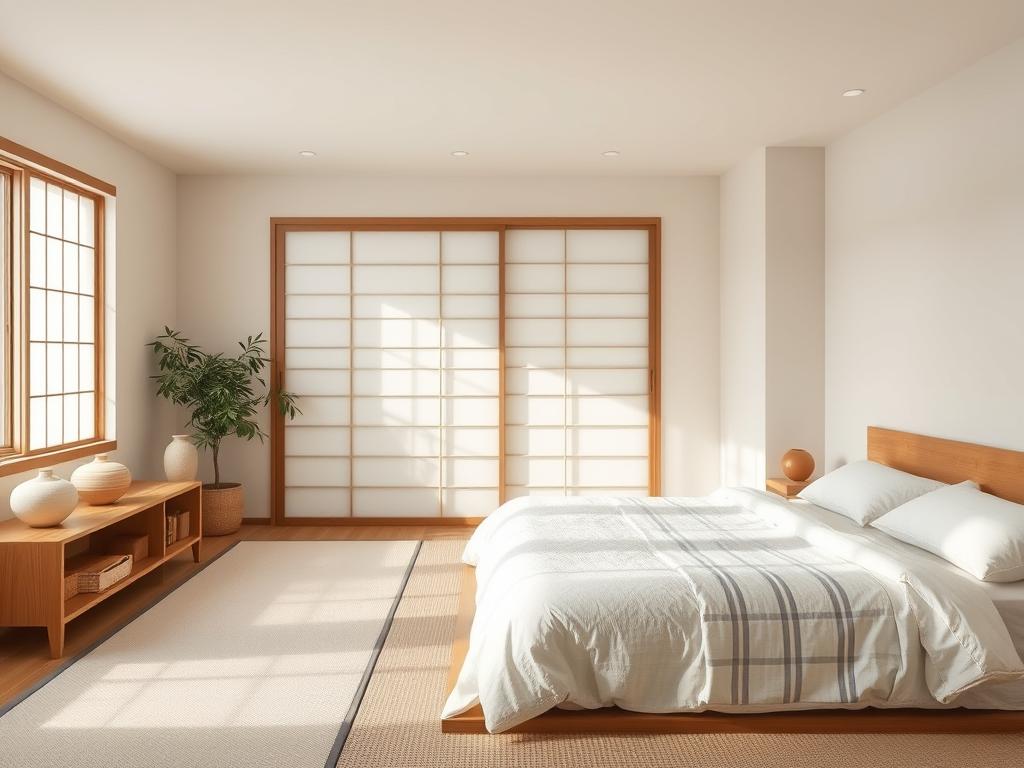
Creating a Japandi bedroom is more than just style. It’s a lifestyle of simplicity, nature, and quality. With neutral tones and texture layers, you can make a peaceful retreat that feels tranquil and purposeful.
| Texture | Material | Effect |
|---|---|---|
| Soft Linen | Organic Cotton | Comfortable and inviting feel |
| Natural Fibers | Jute Rug | Organic texture and contrast |
| Warm Throws | Wool | Adds coziness and warmth |
| Smooth Surfaces | Wood | Creates a calming effect |
| Woven Baskets | Natural Materials | Enhances visual richness |
Earthy Hues: Adding Warmth and Depth
Creating a Japandi bedroom means using earthy hues for warmth and comfort. This mix of Japanese and Scandinavian styles loves simplicity and nature. Muted tones like clay browns, soft sage greens, and pastel blues make it cozy. It’s the ideal place to relax.
Incorporating Natural Colors
Using natural colors in your decor makes your space look better and feel deeper. Try painting a wall in a warm earth tone or pick bedding in these hues. Mixing shades creates a rich, inviting look. Here’s how to add these colors to your Japandi bedroom:
- Use clay brown for walls to create a cozy backdrop.
- Introduce soft sage green accents through pillows or throws.
- Opt for bedding in pastel blue to enhance the feeling of tranquility.
- Consider natural materials like wood or bamboo for furniture to complement earthy hues.
- Incorporate live plants to boost mood and add organic texture.
Adding natural colors to your design makes it warmer and more peaceful. Studies show natural elements help us relax more. As you use earthy hues, your space will show off nature’s beauty while staying true to Japandi decor.
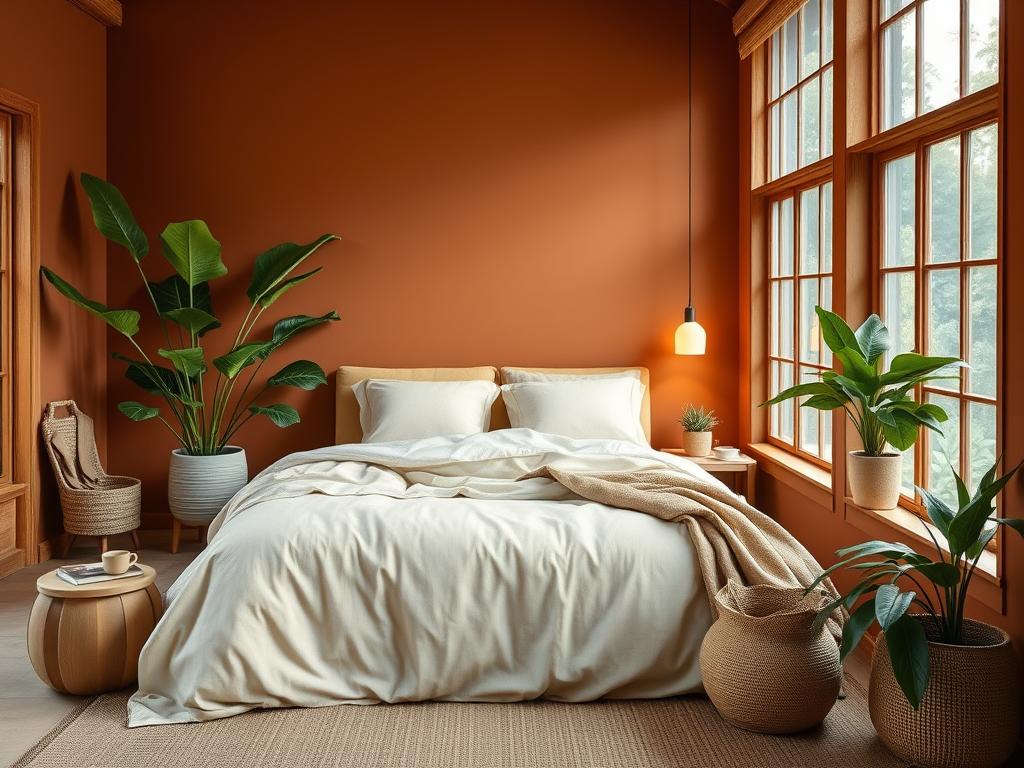
Furniture Selection for Japandi Bedroom Interiors
Choosing the right furniture is key to a Japandi bedroom’s look. Look for furniture with clean lines and warm wood finishes. A minimalist desk can be both a bedside table and a workspace.
Choose furniture that is both stylish and functional. This helps keep your space clutter-free and peaceful. Finding the right balance between function and style is important for a Japandi design.
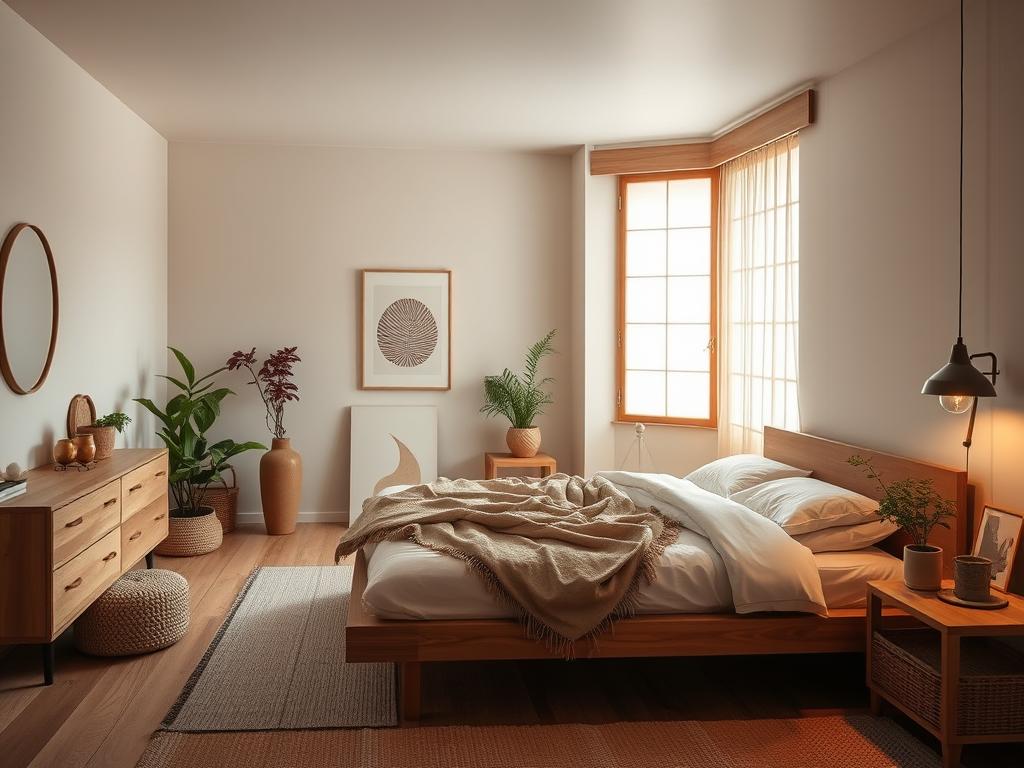
- Choose natural materials such as wood, linen, and ceramics that reflect craftsmanship.
- Incorporate textures that enhance the calming ambiance, using items like soft quilts or organic textiles.
- Utilize a mix of wood tones to enrich your space with visual interest, while keeping with the Japandi theme.
- Emphasize natural light by selecting furniture that allows for openness and connectivity with the outdoors.
| Furniture Type | Key Features | Benefits |
|---|---|---|
| Low-profile Beds | Sleek lines, wooden frames | Creates a grounded atmosphere |
| Minimalist Desks | Multi-functional use | Versatility for space-saving |
| Storage Solutions | Effective organization | Maintains tranquility |
| Natural Material Seating | Soft textures | Enhances comfort and natural aesthetic |
By choosing furniture that is both functional and simple, you can bring Japandi style into your home. This style offers a modern yet peaceful way of living.
Low Profile Beds: Creating a Grounded Atmosphere
Adding low profile beds to your Japandi bedroom can really improve the look and feel. These beds, which sit close to the floor, save space and bring a calm vibe. They match the Japanese wabi-sabi and Scandinavian hygge styles well.
Choosing a natural wooden frame and crisp linens makes your bed a peaceful centerpiece. It invites calm into your space.
When picking low profile beds, focus on earthy tones and simple designs. A color scheme of muted grays, warm earth tones, and soft whites is key for a calm atmosphere. This choice helps keep your room open and airy, perfect for a minimalist look.
Using organic materials like wood and textiles adds warmth and grounding to your space. This is crucial in the Japandi style. Handcrafted items or simple textures help create a stable, calming environment. Your low profile bed is the heart of your peaceful bedroom, blending function and beauty.
